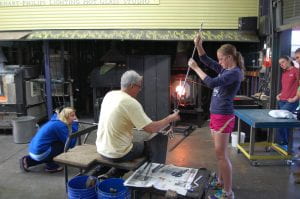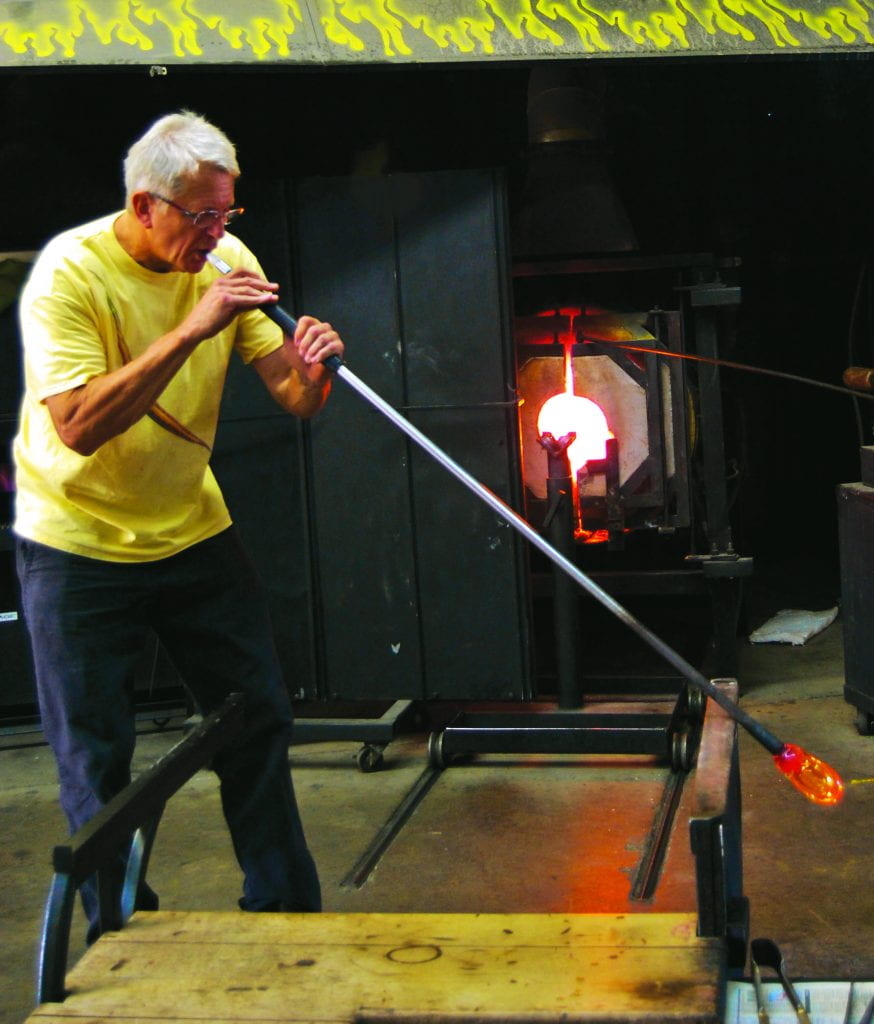By DANA REYNOLDS – STAFF WRITER
PROFESSOR STEPHEN POWELL INTRODUCES STUDENTS TO AN ART FORM THAT IS TOO HOT TO HANDLE
In the year 1985 the first furnace was found on top of the Norton Center for the Arts. Without a doubt, Professor Stephen Powell’s introductory-level course to the art of glass blowing has come a long way since its inception.
Powell, a graduate from Centre, began his career in ceramics before practicing the art of glass blowing. He taught ceramics and painting in Birmingham, Al. before attending Louisiana State University’s (LSU) graduate school in ceramics. Returning to Centre as a visiting professor of ceramics, Powell’s discovery of glass blowing keeps him rooted in Danville. Along with teaching the introductory course to the glass-based art form this semester, Powell also showcases his own art in exhibits throughout the country.
According to senior Cheyenne Evans, the best part of the course is watching Powell work.
“He is absolutely amazing. Seeing him demonstrate techniques for us [to use on our own] during class is always fun to watch,” Evans said. “I love sneaking in and watching him as he does his professional work after class.”
The course starts with the basics, beginning with learning how to blow a round bubble. The class gradually learns how to give the glass shape and add decorative colors. Powell adds lecture into the course and exposes students to contemporary art.

The class is limited to sixteen students and requires work outside of class on the students’ own time. In addition to working on projects at their own pace, the art students are required to come in twice-a-week for three-hour time slots, which is when they really focus on their developing artwork.
Powell understands that most of his students do not plan on pursuing glass blowing as a career, but feels as though it presents them with a different way of thinking.
“I have found that many of my students take one class and then decide to take another,” Powell said. “I hope that it enriches their life in some way. Some people do not think that they are creative and glass blowing exposes them to something interesting.”
Senior Megan Foley, an international studies and history double-major, decided to enroll in the class and learn how to work with glass as an art form because she wanted to take something outside of her two majors.
“I wanted to take something different as well as something I knew would challenge me. I am not particularly gifted artistically [but] I thought glass blowing would be a potentially doable alternative to basic drawing and painting,” Foley said. ”My favorite part of the class so far has been its flexibility and freedom. I think this class has enriched my Centre experience by making me a more rounded person.”

However, glass blowing can be an intimidating experience at first—not only in learning how to create art from glass but in learning how to take the heat. The furnace runs around 2,200 degrees Fahrenheit. Students have to learn to handle the heat in the studio and how to trust their partners.
“You can get burned—and I mean really burned. Learning how to get in and out of the furnace can be a little scary, but once you get used to that and get used to trusting your partner,it is so much fun,” Evans said. “I’ve never really been scared in class, but I am definitely always aware of my surroundings. There’s a lot going on in the studio, so you just have to pay attention to what you’re doing.”
For Foley, her first impressions of learning how to use the furnace misled her, making her believe that working with and around such extreme temperatures would be relatively simple to endure.
“It is very cool to watch Professor Powell do demonstrations,” Foley said, “but I soon realized that it is not as easy as he made it look. The furnace was a lot harder [to use] than I thought it would be.”
Evans has enjoyed the class so much in her three weeks of being enrolled that she plans on taking another glass blowing class in the Spring.
“I have loved every minute of the course. Professor Powell has been the greatest instructor. He’s patient, willing to work with anyone who asks, and incredibly humble. I feel so lucky to be able to study glass with him,” Evans said. “Such unique opportunities as glassblowing are indicative of how much Centre really encourages [the opportunity to become a] well-rounded student.”
